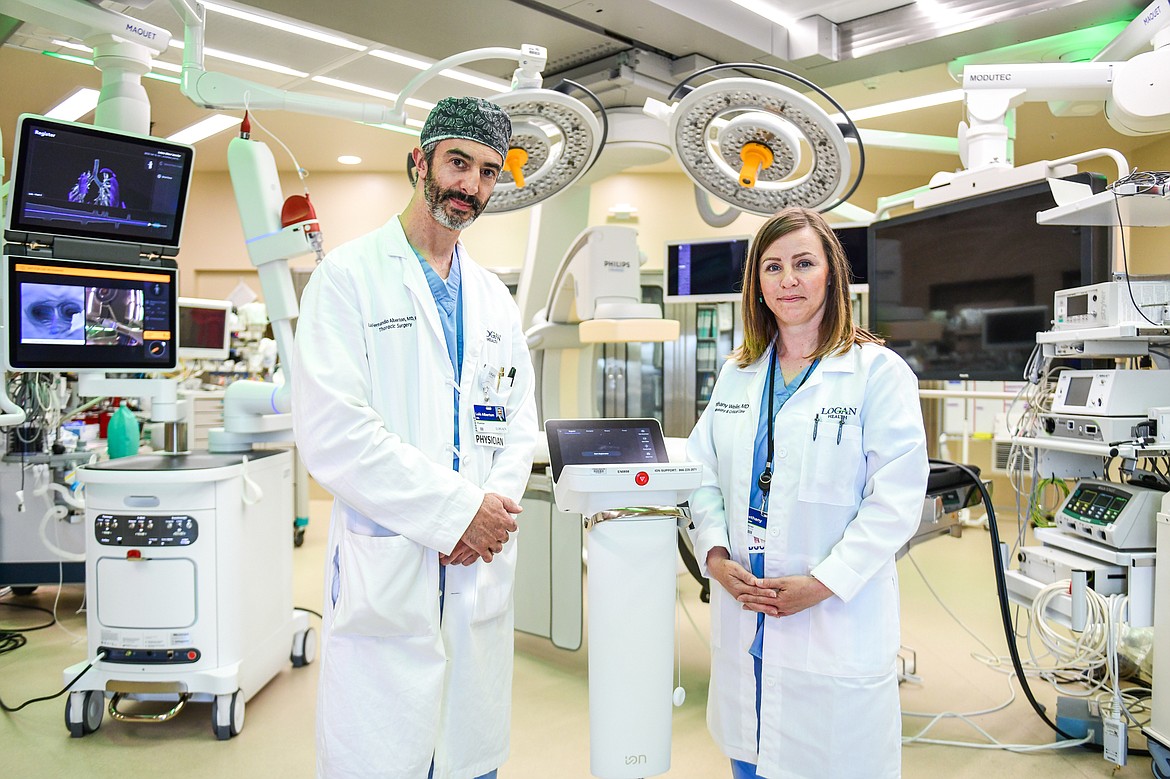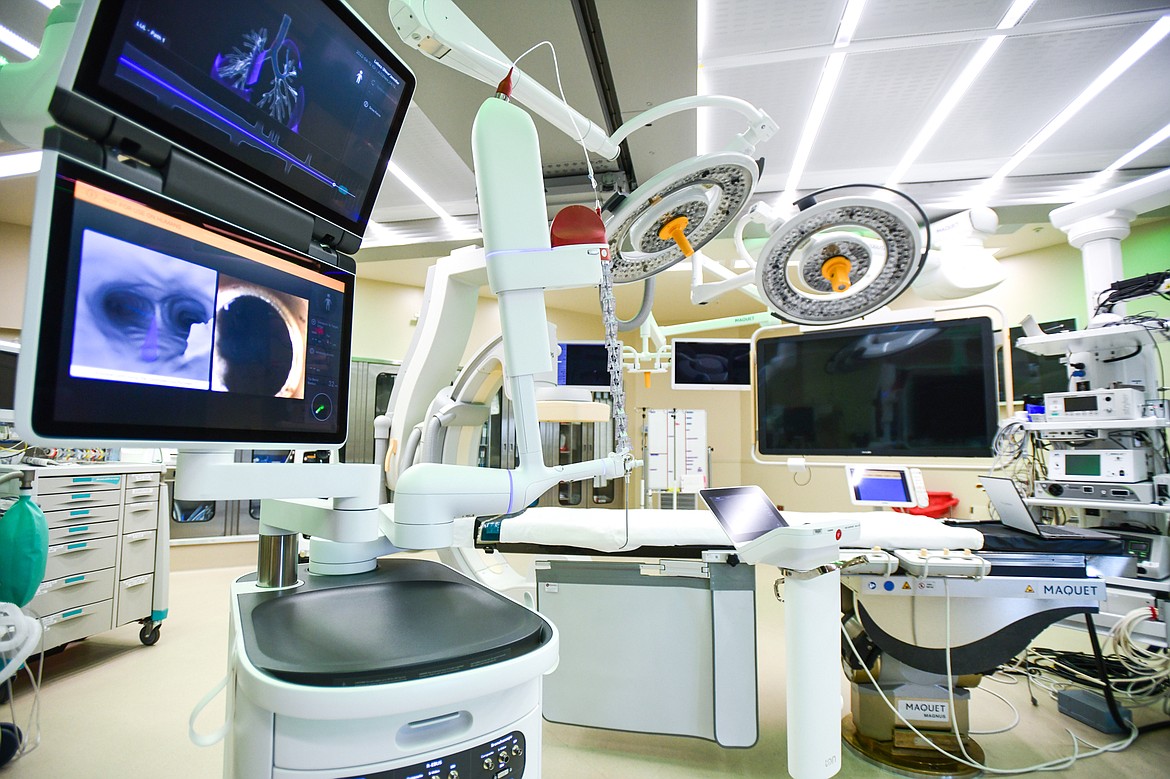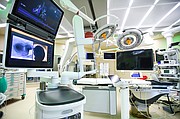Logan Health brings in new robotic-assisted platform for lung biopsies
The Flathead Valley sees more than the average amount of lung cancer cases when compared to other parts of Montana and the rest of the United States.
That’s according to Logan Health Medical Director for Intensive Care and Respiratory Care Services Dr. Bethany Weiler, who said the hospital’s recent investments in lung cancer prevention will help patients get state-of-the-art care close to home.
Weiler has worked at Logan Health for six years. In addition to her role as medical director for respiratory services, she’s also the position lead for the pulmonary and critical care group and the head of the recently created high risk pulmonary nodule clinic. She and other doctors in her unit see asthma, chronic obstructive pulmonary disorder and lung cancer patients — among other issues affecting the lungs.
About a year-and-a-half ago, she and her team advocated for the purchase of a new Ion endoluminal system, a robotic-assisted platform for minimally invasive lung biopsies. The machine will let doctors more quickly and safely find nodules or an overgrowth of cells that could be cancerous.
The Logan Health Foundation bought the Ion with the help of a dedicated donor. Once they heard they would be receiving the machine, providers in respiratory care services sprang into action.
If you or a loved one had to wait up to three weeks to figure out if a lung nodule was cancerous, it might drive you a little crazy, Weiler said. She and her colleagues didn’t want to see their neighbors go through such a long waiting period, so they opened the high risk pulmonary nodule clinic on June 1.
“We said, ‘Alright, so we've got this machine, we've got the state of the art equipment, we now need to build a program around it that expedites these patients through this pathway,’” Weiler said.
There is risk associated with certain lung biopsies, specifically when doctors find a small spot, or nodule, towards the edge of the lung. If this type of nodule is found in a patient, they typically wait and see if it will grow or change before interfering. If it must be explored, the biopsy requires a needle to the chest or a surgery that will result in a hospital stay.
There is a higher risk of a collapsed lung, or pop lung pneumothorax, with these procedures because doctors are entering from the outside. The edge of the lung is called the pleura, and Weiler said anytime doctors have to go through it, the chance for collapsed lung is really high.
Their new robotic-assisted platform uses bronchoscopy, which Weiler likens to a colonoscopy for the lungs — a long tube affixed with a camera that allows a look at the lungs from the inside. This means there is no need to go through the pleura to get to those hard to reach areas of the lung.
Navigating the lungs is tricky. One big airway splits off into two, then they split again and again, until you get into the smallest airways we have, Weiler said. It’s very challenging to navigate, she said.
But, the team’s new robotic-assisted platform creates a map of a patient’s lungs from a CAT scan and tells doctors how to reach a nodule using GPS-like technology.
“You're running the machine and it will tell you, ‘left hand turn here, right hand turn here,’ it sort of helps you navigate out to these nodules,” Weiler said. “... Not only does it improve our accuracy, we're actually able to get out there and get good samples of these small nodules, but also improve the safety profile for the patient.”
This quickens the process for patients suffering from cancer, a goal for the high risk pulmonary nodule clinic.
“We'll be able to biopsy smaller and more peripheral lesions and potentially diagnose those lung cancers earlier than we would have otherwise,” Weiler said. “It definitely will help get patients from identification of a spot on the lung or a pulmonary nodule to treatment quicker.”
According to the National Cancer Institute, lung cancer is the deadliest type of cancer in the United States — claiming more lives than breast, prostate and colon cancer. More than 230,000 Americans are expected to be diagnosed with lung cancer in 2023 and estimates project approximately 127,000 deaths from the disease.
To make things more complicated, Weiler said there aren’t really any symptoms of early lung cancer.
“What makes it so challenging is by the time that you develop symptoms, it's because that lung cancer has grown so big that it's moved into other vital structures or it's gone into other areas like bone or even your brain,” Weiler said.
If lung cancer is found at an earlier stage, when it is small and before it has spread, it is more likely to be treated successfully, according to the American Cancer Society.
That’s why it’s important to get lung cancer screenings. Weiler said pretty much every health insurance company will cover the cost of an annual screening for former and current smokers. Annual screenings are recommended for people who have smoked “greater than 20 Pack years,” which means smoking a pack of cigarettes a day for 20 years or a half a pack a day for 40 years— primarily for people between the ages 50 and 80.
Weiler hopes they are able to catch lung cancer earlier for their patients at Logan Health. She said the addition of cancer navigators at Logan Health has also helped patients immensely. These navigators are specialized nurses who help patients find their way through an oftentimes confusing health care system. The team’s lung cancer navigator helps patients get to appointments, fill prescriptions and generally works to eliminate barriers to treatment.
There’s a whole team of people who will help a patient through a cancer diagnosis at Logan Health. Still, for lung cancer, prevention is the name of the game, Weiler said.
“You can decrease your rate of dying of lung cancer by about 20% if you get into these screening programs. So by far and away, that is the best way to combat lung cancer. Because if you wait for symptoms, you've waited too long,” Weiler said.
Anyone interested in getting a lung cancer screening should ask their doctor. For more information about Logan Health’s pulmonary programs, go to: www.logan.org/health/services/heart-lung-and-vascular.
Reporter Taylor Inman can be reached at tinman@dailyinterlake.com.
Support local journalism — subscribe to the Daily Inter Lake today.



